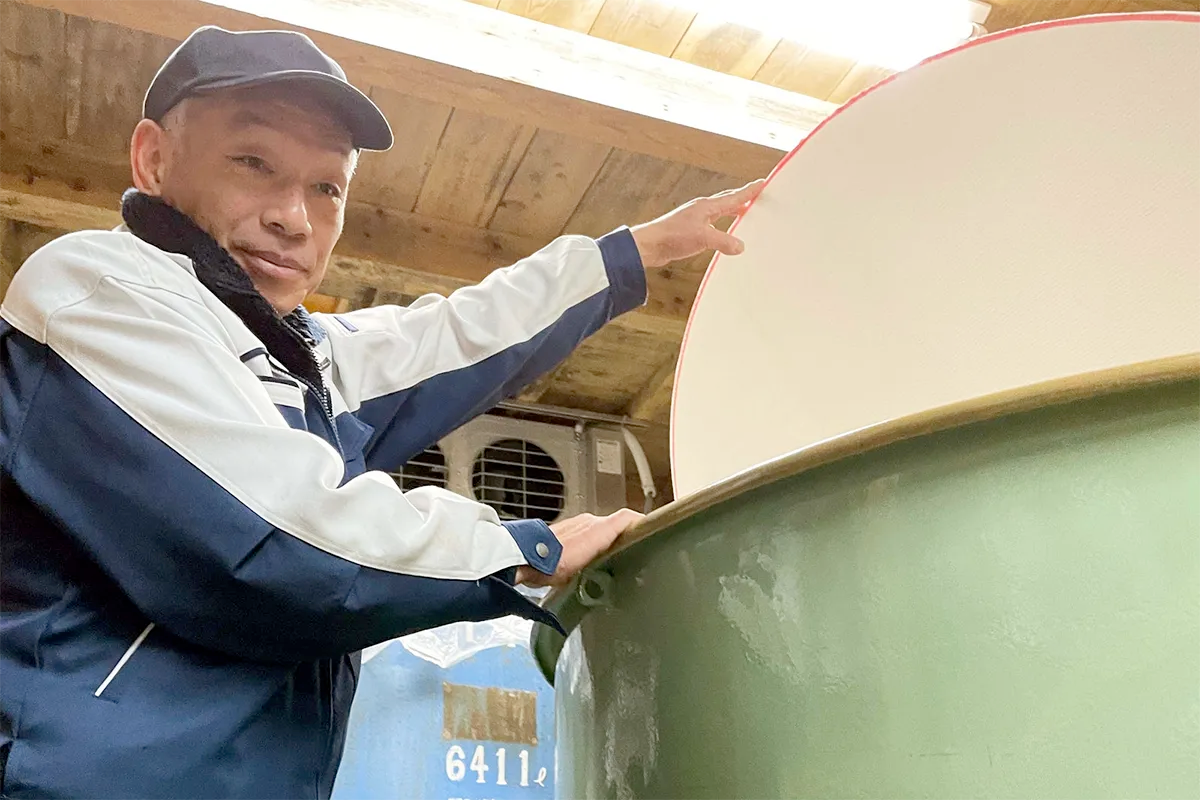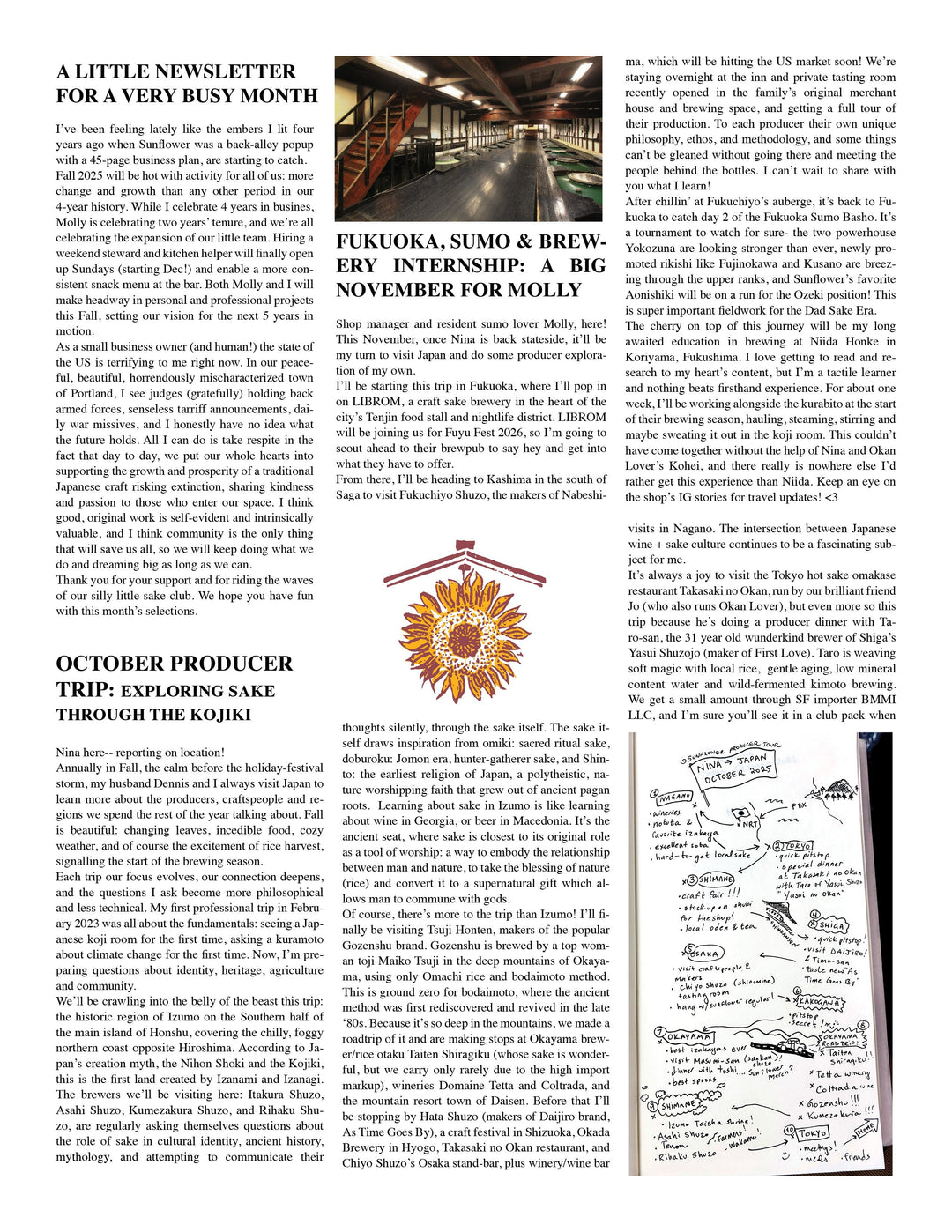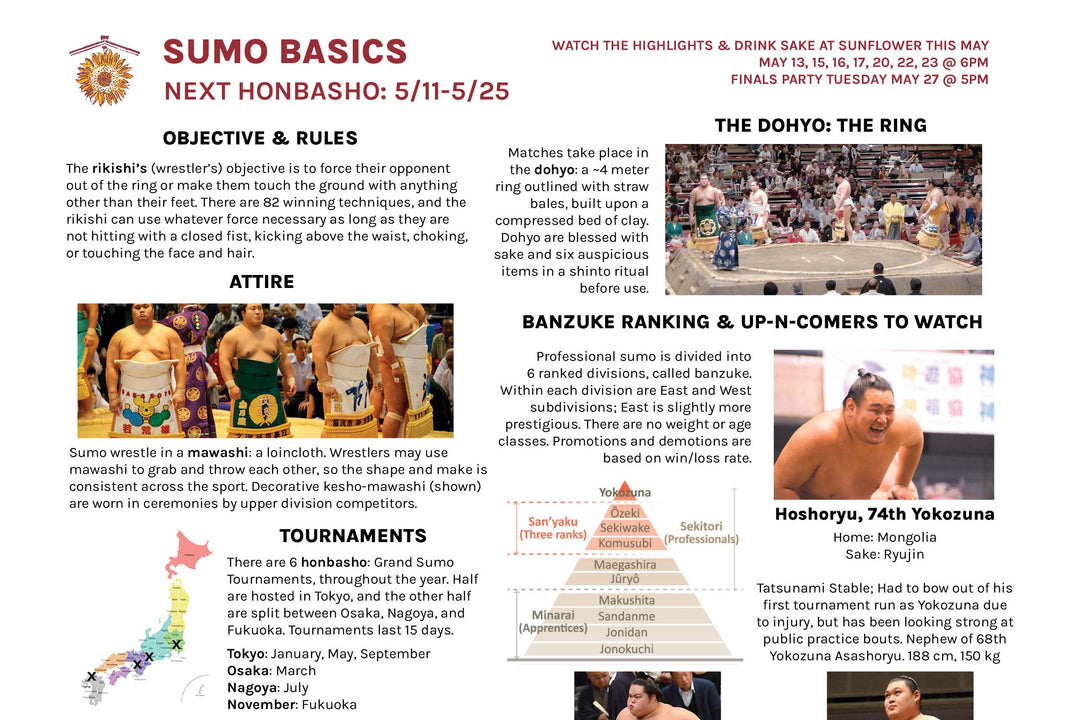Matsunoi: The Lone Pine of Tokamachi

Matsunoi Tokubetsu Honjozo "Lone Pine" (formerly Wishing Well)
In the deepest heart of Niigata’s snowy mountain valleys, past the sleepy artists’ hamlet of Tokamachi, lies a tiny village of Ueno. At the nearby Farmer’s Market (a corner store with villagers’ produce and foodstuffs) you can get a small bowl of hot noodles for 350 yen (about $2.50) or soba-filled inarizushi made by a neighborhood grandma for 60 yen (less than 50c) apiece. We rode in on the last train of the evening, which left Toyono station at 5PM and wove slowly along the Shinano riverbank– 23 local stops– as snow fell softly, an everyday occurrence. The train seats were upholstered in mismatched velvet and the car was empty.
That night, we stayed in an upstairs guest unit managed by an elderly couple and their cat, Maru. The house is 160 years old and the rice, pickles and root vegetables in our bowls that evening, they grew organically last Summer. Dad loves sake, and he’s happy I’m here to visit Matsunoi. Their daughter, who drove in from her apartment 30 minutes away, comments that the toji’s wife works one day a week at the local community center, where they’ve chatted sometimes.
Yutaka Furusawa is a classically trained Echigo Guild toji. His style is clean, dry on the finish, with a robust core. Everything in the brewery is old, recalling the era when Matsunoi produced bulk sake under contract for big breweries, or a decade ago when his late brother was toji, and Matsunoi drew accolades for a string of national competition trophies. A melancholy lingers behind the sense of humor and duty.
After the tour, grandma hustles over with her homemade sake kasu daikon pickles (they are amazing: sweet, tart, pungent!) and we taste through the lineup (it’s equally amazing: fresh, dynamic, soft and crisp!) I’m freezing in the warehouse: the building is surrounded by 5 feet of snow and it’s still falling, but I happily quench my thirst with taste after taste of ice-cold sake.
We exchange gifts. I brought Furusawa-san a bottle of Kelly Fox Pinot Noir, the most noble Oregon emissary I can think of, and he offers me two bottles from the lineup that I was openly thrilled about (honestly, everything from futsuushu– table sake– to competition daiginjo, was wonderful). To warm up, we visit a famous local hegisoba restaurant that also happens to have a startling 1300 Google reviews (!) and 5 occasions presenting their food to the imperial court. The noodles are slippery, bouncy, pale green, and proudly served with Matsunoi, made less than a mile away. I ask him what he’d like to see in the future and he says he’d like to get back to pre-Covid production, about 1000 koku versus the 600 they are making now. The only real strategy he knows is to focus on making the best possible sake as cheaply as possible without cutting corners. Frankly, I’m shocked. At $6 USD (792 yen) for 720ml, Matsunoi’s futsuushu is incredible. It’s a value even at 5x that price. If history is any indication, undervalued products eventually do get noticed… and I sincerely hope he gets his moment soon.
ABOUT
- Brewery: Matsunoi Shuzo
- Location: Ueno, Tokamachi, Niigata
- Water: Soft Shinano River underground flows, piped ~2km to the brewery. No filtration or adjustments needed.
- Rice: local Gohyakumangoku and Yuki no Sei
- Polishing level: 58%
- Grade: Tokubetsu Honjozo
- Yeast: #701 and#10
- Starter: Sokujo
- Alcohol: 15%
- Acidity: 1.3
- SMV: +5 (dry)
FLAVOR NOTES
Tasting very differently at the brewery (bottled only two weeks prior) versus the shop (bottled 9 months ago), one can clearly see that this sake evolves over time, gaining depth and richness of flavor. At the shop, this tokubetsu honjozo tastes of toasted coconut sugar, pine cones, peeled almonds, vanilla, pear, kombu, and crisp spring water. It has a mild and clean savory-sweet aroma and a soft, silky, water-like texture. The flavor builds on each sip, filling the mouth with flavor, then dissipating elegantly after swallowing. This is about as good as honjozo gets: sessionable, balanced, gently aromatic and maturing beautifully.
HOW IS IT MADE, & WHY DOES IT TASTE THIS WAY?
Honjozo is a unique and historic style of sake in which a limited amount of neutral brewers alcohol (usually 95% brewers alcohol imported from South Africa or Chile) is added to sake at the end of brewing but before pressing, allowed to steep a short while to extract alcohol-soluble flavor and aromatic compounds, then pressed and diluted with water to 15-16% ABV. This method has been in use since the Edo period (~350 years ago) and while the science was not understood at that time, it was apparent that alcohol-added sake was less susceptible to spoilage, more stable in transport, and aged well: the same lessons Europeans learned in Portuguese and Spanish winemaking at around the same time. To legally qualify as honjozo, up to 10% of the rice (by weight) can be added as alcohol prior to pressing, and rice must be milled to 70% or less of its original size. These rules are in place to ensure that honjozo remains a high quality style, or a tokutei meishoshu-- “special designation”– sake, distinct from futsuushu– “regular sake,” whose alcohol and milling rates are not controlled. It’s worth noting that honjozo is one of the most rapidly falling categories of sake, unjustly maligned as being artificial due to its added alcohol content. This is despite the fact that among brewers, aruten (alcohol-added sake) is considered the absolute highest craft and a well-made aruten identifies those with the most skill in brewing.
So how does this affect the flavor of Lone Pine? Tasting this sake fresh and lightly aged, it’s clear that the main impact of the alcohol is ensuring a clean yet rich evolution in flavor. The fresh version has lifted aromatic notes of fruit, clove, and wintergreen, while the aged version settles into richer notes of baked pear, nutmeg, and nuts. What it retains in this age is a refreshing, clean and dry character– an effect of the alcohol dilution– that junmai tends to lose. The alcohol also offers a slightly different, more lifted aromatic vapor which I could almost describe as the aroma of an infused distillate like gin or perfume. It’s a unique effect and very difficult to execute properly.
The relatively hard varieties of rice used (Gohyakumangoku, Yuki no Sei), grown locally, are milled down to ginjo levels of 58%, qualifying the sake as “tokubetsu”: special. It’s also brewed slowly, slowly, slowly in an extremely cold environment, which causes 1) less rice to dissolve in the mash– leaner body and sharper finish, and 2) evokes more character from the cold, stressed-out yeast. These factors, which help define the Niigata style, also contribute to the character of Lone Pine.
STORAGE
Store the unopened bottle in a cool, dark place (wine fridge is ideal, otherwise away from the stove in a cabinet). Enjoy within a year. Once open, enjoy over the course of 2-8 weeks (or more) and watch it gain additional depth.
HOW TO ENJOY?
Honjozo is an extremely versatile style. Being dry and crisp, it refreshes the palate between bites and accents the umami of food. Being lighter in body and flavor than junmai, it’s more sessionable and flexible with pairing. Lone Pine can be served at any temperature (chilled, room temp, warm, hot) and evolves with time as the bottle sits open.
At the brewery this was served with grandma’s sake kasu pickles but as these are hard to find in the US, any sweet-tart pickled vegetable, miso-based dish, or jerkied fish/meat will pair very nicely. This area of Niigata is famous for chewy, bouncy soba served with mustard (wasabi won’t grow here– too cold) and this would be the classic immediately regional pairing… but Furusawa-san said any pork pairs very nicely (this region is famous for its heritage pigs, including ham, sausages & charcuterie) as well as processed cheese: Laughing Cow’s Japanese scallop-flavored bites are his favorite (but he likes the plain Laughing Cow, too!)
In my own experience at the shop and at home, Matsunoi has become a versatile go-to (like Masumi Junmai) for all types of Japanese and western food, but especially more flavorful/oilier food. In the sushi world this would include maguro, unagi, tamago, inarizushi, saba, takuan, or our American classic: cream cheese and salmon. Miso braises, roasts, nabe (especially chicken, pumpkin or pork), jajangmyeon, kbbq and japchae.In the Western culinary world, Alpine cuisine (ex. lamb or rabbit ragu, truffles and porcini, polenta, semi-firm aged cheeses), roast duck and game, are excellent places to start.
Or even a simple bowl of instant ramen or udon soup. Matsunoi’s sake can be dressed up or down– doesn’t matter. That’s the real indication of a great honjozo.
Purchase Matsunoi Tokubetsu Honjozo here to support a snowy mountain superstar.




